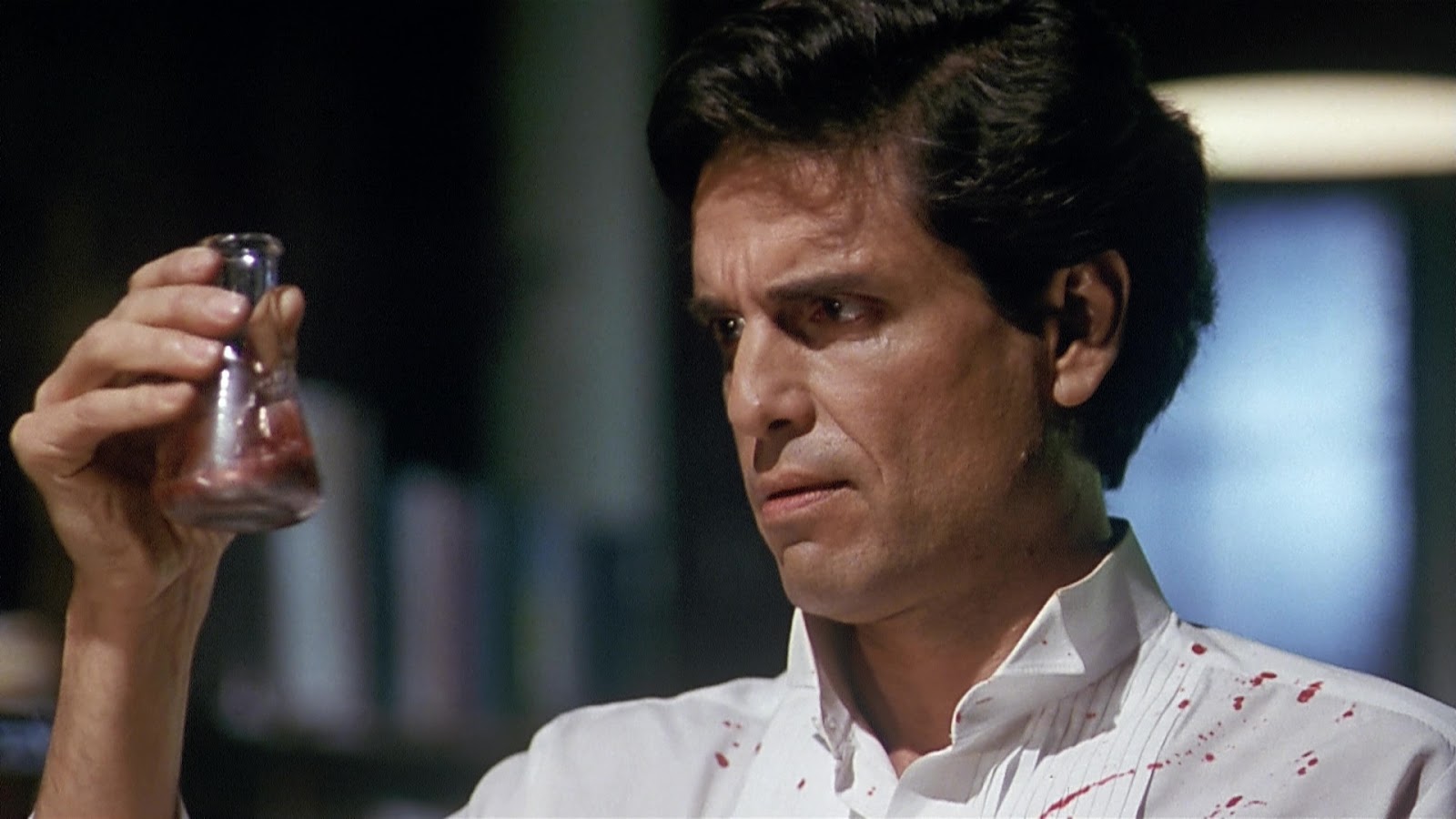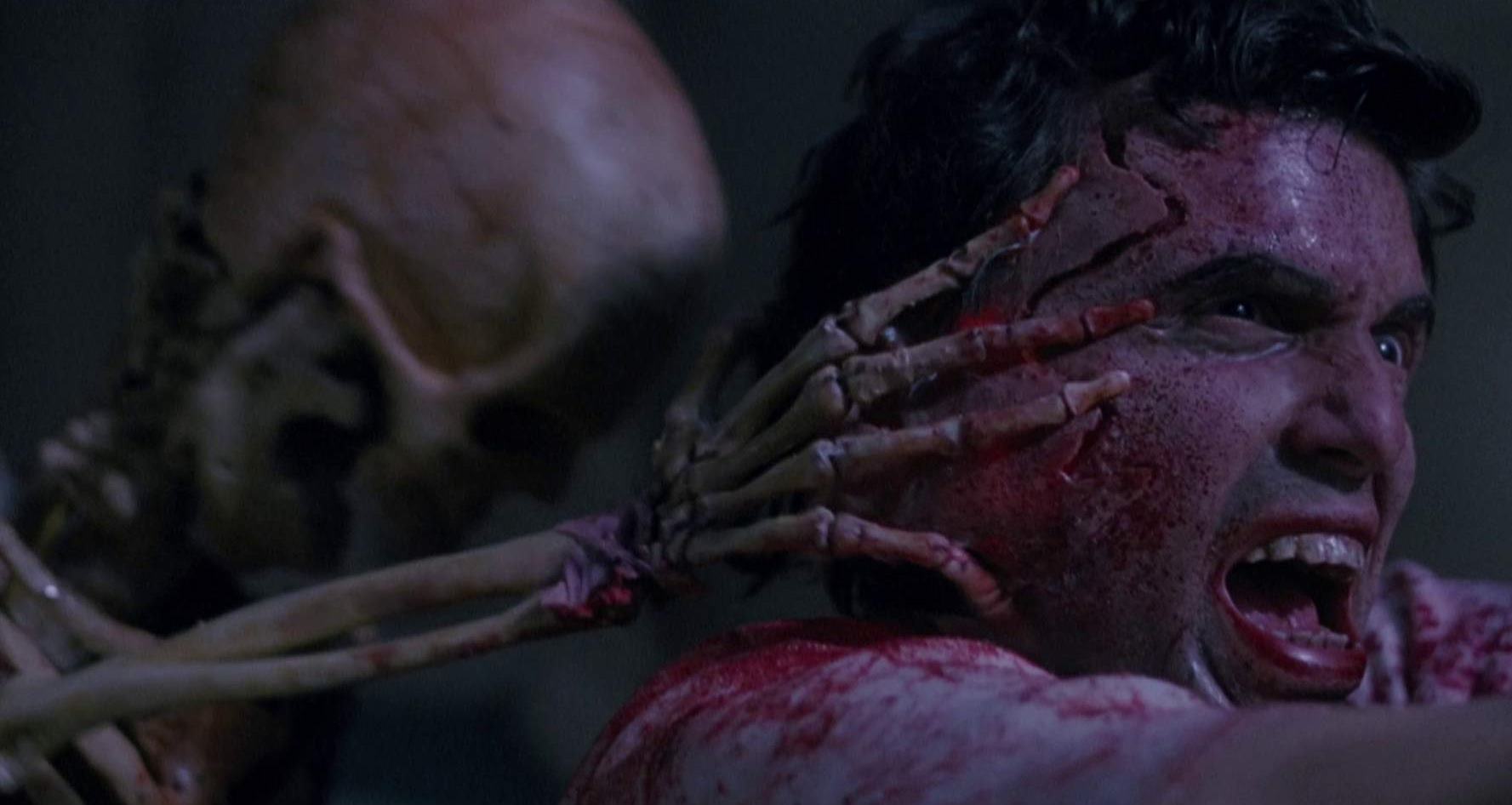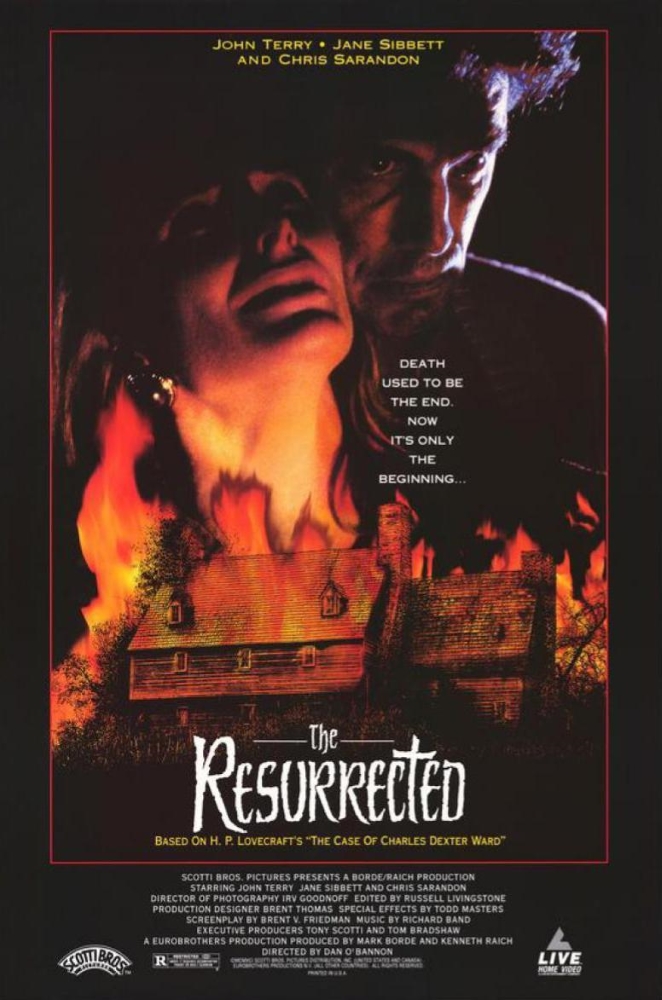USA. 1992.
Crew
Director – Dan O’Bannon, Screenplay – Brent V. Friedman, Inspired by the Short Story The Case of Charles Dexter Ward (1941) by H.P. Lovecraft, Producers – Mark Borde & Kenneth Raiche, Photography – Irv Goodnoff, Music – Richard Band, Visual Effects/Makeup Effects – Todd Masters Co Ltd (Supervisor – Todd Masters), Special Physical Effects Supervisor – Gary Paller, Production Design – Brent Thomas. Production Company – Scotti Brothers Pictures.
Cast
John Terry (John March), Chris Sarandon (Charles Ward/Joseph Curwen), Jane Sibbett (Claire Ward), Richard Romanus (Lonnie Peck), Laurie Briscoe (Holly Tender), Patrick Pon (Raymond Chang)
Plot
Private detective John March narrates an incredible story. He was contacted by Claire Ward who was concerned about her husband Charles who had become obsessed with conducting mysterious experiments and was then apprehended by the police for smuggling dead bodies into the country. As March investigated, he discovered that Ward believed he had been taken over by the spirit of his 18th Century ancestor, the black magician Joseph Curwen. He had taken to eating raw meat and appeared to be connected to a series of killings where the victims had been eaten. As March penetrated the labyrinth underneath Curwen’s former house, he encountered abominable mutations and discovered that Ward had created a formula that resurrected the dead.
One of the great mysteries of the 1990s and 00s was “What ever happened to Dan O’Bannon?” As scriptwriter, Dan O’Bannon made two grandslams in the 1970s with the scripts for Dark Star (1974) and Alien (1979). O’Bannon then went on to deliver some fine hard-edged scripts, including the likes of Dead & Buried (1981), Heavy Metal (1981), Blue Thunder (1983), Lifeforce (1985) and Invaders from Mars (1986), before making an excellent directorial debut with Return of the Living Dead (1985), which inverted George Romero’s Dead trilogy with a cheerful punk cynicism. However, in the 1990s, Dan O’Bannon almost entirely dropped from the cinematic radar. There were a number of scripts with his name attached – Total Recall (1990), Screamers (1995) and Hemoglobin/Bleeders (1997) – but all of these were old scripts that had been reworked by other writers.
The Resurrected was Dan O’Bannon’s second directorial outing, the only work in the 1990s where O’Bannon has had hands-on experience. All of which is a shame as O’Bannon is one writer that one wished would return to the genre. [Alas, this is no longer to be the case with O’Bannon’s death in 2009 and it would appear that the reasons for his absence from screens was due to a crippling case of Crohn’s Disease]. Also of note is Jodorowsky’s Dune (2013), a documentary that details O’Bannon’s work as special effects director on Alejandro Jodorowsky’s failed adaptation of Dune (1965) in the 1970s.
The Resurrected is adapted from an H.P. Lovecraft story The Case of Charles Dexter Ward (1941) – the same story had previously been adapted as Roger Corman’s The Haunted Palace (1963). Here Dan O’Bannon is directing another writer’s script – in this case, Brent V. Friedman, a genre writer who has written screenplays for the likes of Syngenor (1990), Ticks (1993), American Cyborg: Steel Warrior (1992), the Prehysteria! sequels and produced genre tv series such as Dark Skies (1996-7), Secret Agent Man (1999-2000) and Woke Up Dead (2008-9), as well as delivering the script for the H.P. Lovecraft portmanteau film Necronomicon (1993).

H.P. Lovecraft’s The Case of Charles Dexter Ward is a relatively straightforward piece about a man being possessed by the spirit of his ancestor that emerges from a portrait. The Resurrected came about as part of a vogue for H.P. Lovecraft that had been created by the success of Stuart Gordon’s Re-Animator (1985). Re-Animator identified Lovecraft with a campy splatter-heavy approach, one that has been taken as lead by the various Lovecraft adaptations ever since.
The Case of Charles Dexter Ward is not on the face of it a Lovecraft story that is geared toward such a splattery approach. Brent V. Friedman ingeniously solves the problem with a series of twists about Curwen not being a disembodied spirit so much as an evil ancestor raised from the dead through black sorcery, thus allowing the insertion of various Hellraiser (1987)-styled bodily reconstitution scenes. [In an interesting trivia note, this is the only H.P. Lovecraft adaptation to use Lovecraft’s home turf (and the story’s setting) – Providence, Rhode Island – as a location (even if the Providence scenes were all shot in Vancouver)].
The Resurrected lacks the energy and vigour that Dan O’Bannon displayed with Return of the Living Dead. Nearly half the film is on the story-heavy exposition side wherein nothing much happens, although O’Bannon and Brent V. Friedman do create a good mystery and some effective images such as the overacting Chris Sarandon suddenly talking in 18th Century tongue.

In the latter half, O’Bannon eventually delivers the goods in a sequence where John Terry, Jane Sibbett and Richard Romanus venture by torchlight down into the catacombs beneath the Curwen home finding arcane diaries, partially raising something from the dead with a serum, encountering half-seen monstrosities in the dark and then the torch going out at the crucial moment and they having to make their way back in the dark by matchlight as the mutations close in. The twist ending and revelations about who is impersonating whom and John Terry’s means of dealing with this are also well done. It is during these sequences that Dan O’Bannon conjures something of the mood of Lovecraft and his sense of abominable experiments, unspeakable monstrosities and forbidden knowledge. This makes The Resurrected one of the few post-Re-Animator films that successfully captures the mood of H.P. Lovecraft.
Other films based on the works of H.P. Lovecraft include:- The Haunted Palace (1963), Die, Monster, Die/Monster of Terror (1965), The Shuttered Room (1967) and The Dunwich Horror (1969). The big success in the modern era was Stuart Gordon’s splattery black comedy version of Re-Animator (1985), which popularised Lovecraft on film. This led to a host of B-budget Lovecraft adaptations, including Stuart Gordon’s subsequent From Beyond (1986), The Curse (1987), The Unnameable (1988), Necronomicon (1993), The Unnamable II: The Statement of Randolph Carter (1993), Lurking Fear (1994), Gordon’s Dagon (2001), and other works such as The Dream-Quest of Unknown Kadath (2003), Beyond the Wall of Sleep (2006), Cool Air (2006), Chill (2007), Cthulhu (2007), The Tomb (2007), Colour from the Dark (2008), The Dunwich Horror (2009), The Color (2010), Pickman’s Muse (2010), The Whisperer in Darkness (2011), The Dark Sleep (2013), The Haunter of the Dark (2015), Herbert West: Re-Animator (2017), Color Out of Space (2019), H.P. Lovecraft’s The Deep Ones (2020), the tv series Lovecraft Country (2020), Markham (2020), H.P. Lovecraft’s Witch House (2021), The Resonator: Miskatonic U (2021), The Lurking Fear (2023), Suitable Flesh (2023), H.P. Lovecraft’s The Old Ones (2024), The Innsmouth School for Girls (2024) and Unspeakable: Beyond the Wall of Sleep (2024). Lovecraft: Fear of the Unknown (2008) is a documentary about Lovecraft. Also of interest is The Manitou (1978), which features an appearance of the Great Old One; Cast a Deadly Spell (1991) and its sequel Witch Hunt (1994), a tv movie set in an alternate world where magic works and where the central character is a detective named H.P. Lovecraft; Juan Piquer Simon’s cheap and loosely inspired Cthulhu Mansion (1992); John Carpenter’s Lovecraft homage In the Mouth of Madness (1995); the fan parodies Lovecracked: The Movie (2006), The Last Lovecraft: Relic of Cthulhu (2009) and Call Girl of Cthulhu (2014); even a trilogy of animated children’s film Howard Lovecraft and the Frozen Kingdom (2016), Howard Lovecraft and the Undersea Kingdom (2017) and Howard Lovecraft and the Kingdom of Madness (2018) in which a young Lovecraft encounters his own creations; while Batman faces Lovecraftian horrors in the animated Batman: The Doom That Came to Gotham (2023); and Lovecraft homages such as The Breach (2022), H.P. Lovecraft’s Monster Portal (2022) and Gods of the Deep (2023). The Elder Gods turn up at the end of The Cabin in the Woods (2012), Lovecraft (Paul Titley) appears as an imaginary companion in Ghostland/Incident in a Ghostland (2018) and In Search of Lovecraft (2008) features a tv news crew discovering that Lovecraft’s works are true. Lovecraft’s key work of demonic lore The Necronomicon also makes appearances in films such as Equinox (1970), The Evil Dead II (1987) and Army of Darkness (1992), and was also borrowed as an alternate retitling for Jesus Franco’s surreal and otherwise unrelated Succubus/Necronomicon (1969) about a BDSM dancer.
Trailer here


